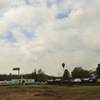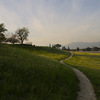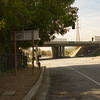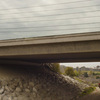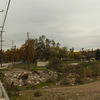A Conversation with Alia Malley
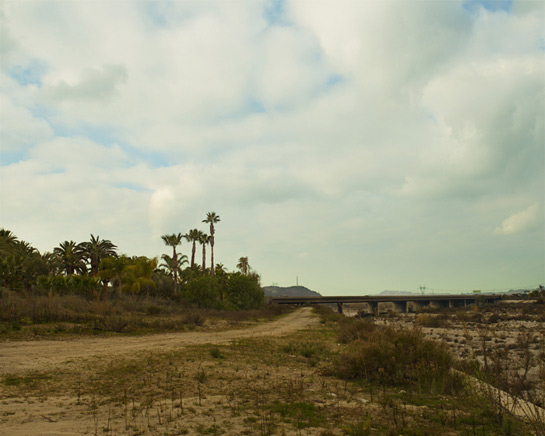
I don’t remember where or how I came across Alia Malley’s 2009/10 Southland, but I do remember the photography stayed with me for a while. There was something about those landscapes that struck me. Recently, someone pointed me to Alia’s new series A Cavalier in Sight of a Village, for which she was (in fact at the time of this writing is) raising money on Kickstarter. So I got in touch with Alia and asked her whether she’d answer my questions about her work. (more)
Jörg Colberg: Part of what draws me to your work is the fact that while it is shot around LA, it doesn’t look like what one would expect to see, maybe based on the depiction of the city that is so ubiquitous. I find that incredibly refreshing. It actually (almost) makes me want to re-visit LA. Another thing that draws me to your work is that it is informed not by other photography - not that there’s necessarily anything wrong with it - but rather more by the tradition of landscape used to be painted. At the risk of asking for your secrets here, how did you arrive at doing this? Why are you interested in the history of landscape painting?
Alia Malley: First, let me say I’m so pleased to be speaking with you, I’m a long time fan of Conscientious.
Los Angeles is a pretty complicated place, and things are often not as they seem. Right now, in terms of weather for example, we’re in the middle of June Gloom, which comes after the month of May Gray, the time of year that the marine layer just rolls in off the ocean and sits over most of LA, especially the western coastal areas. It’s a far cry from the postcard perfection of the sunny-blue-sky and palm-tree imagery that you rightly describe as ubiquitous. Not that that doesn’t exist in LA, but I’m interested in photographing the other sides of LA, the ones that are there but that we often just overlook, or drive past, or otherwise ignore as they don’t fit in with our collective consciousness of what we expect the city to be.
I came to be interested in classical landscape paintings simply by looking at how landscape has been visually represented over the years. I traced it back in photography as far as it would go, and spent some quality time with work of the Survey photographers like Carleton Watkins, Timothy O’Sullivan, and Muybridge too. It was the act of moving through the landscape with a camera, slowly and methodically documenting that experience with great precision, that attracted me to that work. But then I began to consider how landscape was depicted before then, and that is how I came to the world of the painters, especially Constable and van Ruisdael, Courbet, and Corot.
My interest in classical landscape painting coincided with my switch from working with c-prints and Lightjets to the archival pigment printers. And I began to realize that instead of light and chemicals reacting on a resin-coated surface, I was now literally putting pigment on paper, much like paintings or drawings. Photography is inextricably linked to technology, so it’s ironic maybe that the advent of a new technology allowed me to push my work into the realm of another, more traditional medium of landscape representation.
JC: I don’t think I’ve seen this angle before - talking about pigments, put onto paper, as the connection to painting. The usual talk about photography and painting evolves around size - one can print photographs at the same sizes as large paintings, so one can try to achieve whatever it is that painting does. But ultimately that seems to be (at least in part) a somewhat shallow way to approach the subject, even though in reality scale does play an important role for photography. That said, I now wonder whether you see yourself as being part of the tradition of landscape painting (in your case using photography - let’s be open-minded and pretend we can do that) or photography?
AM: Yes I think you’re right about the issue of size. That is an important consideration when making photographic objects, and something I do think a lot about. But as you rightly point out, there is more to it than that. This is probably the same reason I’m not so interested in printing photographs on canvas.
By the time I began graduate school in 2007 at UC Riverside, the color photography darkrooms had been converted into digital workstations. So there was an ongoing conversation about the implications of pigment on paper (and other printable mediums) that was happening there. I resisted the pigment printers at first, but then realized that by changing my printing process, interesting things could happen— a photographic print no longer necessarily had to be the result of light hitting chemicals. So I began experimenting with the rag papers. I spent a year learning how to use machines.
I think this was also a reaction against the fact that the availability of cheap, digital camera technology means everyone and their cat is a photographer now. Which is fantastic in terms of the democratization of art and technology, but ultimately that deluge of imagery makes working with photography a real challenge these days. I mean, how do you make a photograph with a singular voice of its own when something insane like 36 billion images are posted to Facebook each year? Pushing my work into the realm of other mediums in terms of both the images themselves as well as the final objects I’m making—pigment prints on rag paper hinged in frames much like a work on paper would be—has been my approach so far. It will evolve from here, I’m sure.
You also see other contemporary artists working now with a new sort of photographic hyper-abstraction, exploring the materiality of the photograph itself, and I think that is another strategy to combat the same sense of image fatigue I’m describing. There’s no right answer here, but something has to be done.
But back to the landscape. My interest in landscape started out as a casual hook-up, but has evolved into a long-term committed relationship. So yes, in that sense I’d consider my work as being part of the tradition of working with landscape. I work in photography obviously, and love the classical paintings, but am also attracted to artists like Robert Smithson and Richard Long as well. So it’s more of a discursive sense of artists working with landscape. I’m pretty equal-opportunity when it comes to mediums I’m influenced by.
JC: With A Cavalier in Sight of a Village, you even expand your interest, bringing up Roman Polanski’s Chinatown as well as cowboys, and, again, historical painting (here with the twist of seeing a reproduction made in China). The way you described it and your pictures then had me think that at least in that series, you’re more of a story teller than a landscape photographer. And there seems considerable irony in these images, too. You write “Often the scenes in front of me felt straight out of a Western. Or more specifically, a mid-20th century scripted Hollywood version of the 19th century American West. Maybe this imagery is just as phony as the Chinese reproductions. Images based on other images with historical precedence. Or maybe not.” What do you look for when you go out to take pictures?
AM: Photographs are pretty great for making suggestions of narrative— as opposed to a word-for-word, linear story— and that is something for sure that I am interested in. Wim Wenders once said that places themselves have stories to tell, if you listen closely enough. So in that way, photographing these places like I do, it makes sense that there are traces of implied narratives. Those narratives are often pretty fluid though, as opposed to scripted or pinned down. But I prefer it that way.
Working with a camera outside in the material world of LA— as opposed to within the studio— you have to deal with the fact that just about every street corner, arroyo, freeway and empty lot has had something filmed on it. So that’s where that notion of “a representation of a representation” comes from. It’s layers upon layers of that sort of thing here, and I’ll happily leave the semiotics of that to the PhD dissertations. All I know is that from the minute I moved to LA in 1990 to go to film school at USC, and then drove for the first time around that cloverleaf connector from the 10 to the 110 and looked down and saw the old CHP building that was used in the early 1980’s TV show “CHiPs”— that same high angle, rotational view of the building from that cloverleaf that you’d see in the show— I knew this was a crazy place.
In terms of a specificity of what I’m looking for, I don’t really have a check-list that I work from. Mostly it just comes from driving past the same places day after day and thinking, “now that might be interesting….” Sooner or later I’ll stop and get out and take a closer look. Sometimes there’s something there, and sometimes it’s a bust. And it depends on the day, and the time of day too. What looks amazing one afternoon, may not be the next morning. That’s absolutely how Southland came about. For Cavalier, I was spending a lot of time out in that northern part of the Valley, where I ride horses. And as I wrote in the artist statement, one day I literally saw a boy on a white horse down in the arroyo that felt straight out of a scene from Chinatown. You know, I recently re-watched that scene just to make sure my memory of the film had not completely fabricated something, and just the opposite was true: looking at that scene again, I’m 99% sure it was filmed where I actually saw that boy and his horse. It’s nearly 40 years later, but the bridges and the hilly background look nearly identical. No wonder it looked like the movie.
JC: Let’s talk about photography and narratives a bit more. Could you elaborate a little on your ideas here?
AM: I find there is something almost Schrödinger’s Cat-like about trying to create or read too-specific a meaning or narrative onto a photograph. By that I mean, if you leave it alone, often the photograph can happily inhabit multiple positions simultaneously—telling fragments of different stories all at once, both real and imagined— but as soon as you try to really pin it down and declare that the narrative is “this” but not “that”, then that very act of measurement sort of disempowers the photograph.
Instead of forcing a position or linear narrative upon my work, I’d rather just intuitively make the photographs and let them tell their own stories. Sometimes I think it’s better to let the guitar line from the live version of “Bad” just wash over you, instead of trying to figure out what Edge meant when he first played it in 1984.
JC: For A Cavalier in Sight of a Village, you also decided to do a Kickstarter project to raise money to make a book. Which brings up two questions. First, why a book? Can you tell me about the appeal a book has for you?
AM: I’m very much about making photographic objects, and I like to work in a serial format, so it seemed like a natural fit for the Cavalier work. I’ve been thinking about the way my work is experienced and I’ve realized it goes something like this: looking at jpegs online is like listening to the song on the AM radio. Having a book is like owning the album on CD or LP. Seeing the prints in an exhibition is like going to see that band play live. It’s awesome to go rock out at the concert but logistically that’s not always possible. So it’s nice to have the album at home too, where you can listen to it whenever you want. They are all different formats of the same work.
I came to this conclusion while I was working on some jpegs to post online— I always use my lo-fi iMac monitor for that, as opposed to my calibrated monitor when I’m working on prints. It reminded me how I’ve always heard that record producers mix the radio singles on a crappy mono speaker to make sure it will sound good on car radios. I don’t know if that’s true anymore.
JC: There is a big difference between seeing a print on the wall and seeing it in a book, though. I would imagine that for your landscape work that might be an important distinction. I would have guessed that you’d see your work as something that has to be seen on a wall, but I suppose that would have been a bad guess?
AM: Well not necessarily—you do make a good point. Sure, it would be great if my work was always seen in person—I’m deeply invested in the craft of the individual objects and their installation within the exhibitions. But ultimately, visting a gallery in a certain city, or having a private collection in your home, I mean that just isn’t always possible.
But there is also something special about photography books. The reproducibility of a photograph could not be more perfectly suited to books. We could go back to Walter Benjamin’s The Work of Art in the Age of Mechanical Reproduction, and the cultural and political implications of the printed photograph and the mass dissemination of images, but let’s not and say we did.
What I’m getting at is, we don’t see the “Top 10 Best Sculpture Books” lists come out at the end of every year, at least not with the same fervor and enthusiasm. If you have ever walked through a Richard Serra Torqued Ellipse and then been deflated when you flipped through the catalogue in the gift shop on your way out, then you know what I mean. Lucky for us, photography can be represented in a book really well, and even take on a life of its own there. So while, of course, it is a very different experience than viewing the prints in person, it is still a valuable way to have a relationship with the work.
JC: And then Kickstarter. What brought you to Kickstarter?
AM: I had read about Kickstarter, but didn’t have any direct or first-hand experience with it. But I wanted to make a book, in time to accompany an exhibition of the work, and didn’t have a publisher lined up nor the funds to make the book that I had in mind. The one downside to making photographic objects— as opposed to just putting them online— is that it doesn’t come cheaply, and I’m not interested in making half-assed anything. The paper, the inks, the frames… and now the book… it starts to add up. So I needed a way to help make that happen. And Kickstarter seemed like it was worth a try. I had very low (as in: zero) expectations. The response has been really incredible, I’ve been bowled over by the amount of support so far.
 By
By 
